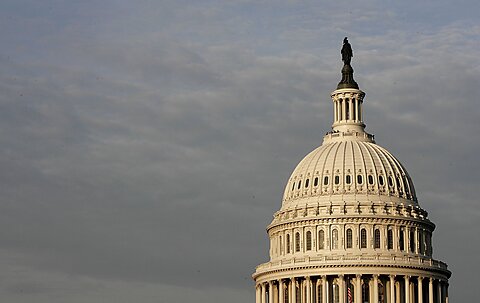In a recent speech, GOP presidential contender Vivek Ramaswamy outlined a multi‐year plan to reduce the federal workforce by 75 percent, slash regulations, and “shut down redundant federal agencies,” if elected. While Ramaswamy’s goals may seem fantastic, scholars at the Cato Institute have presented detailed policies for reducing the size of the federal government and its workforce.
In 2022, for instance, economist Chris Edwards, the editor of Cato’s DownsizingGovernment.org, published a detailed plan of specific cuts to the federal budget. These spending reductions, phased in over 10 years, would “by 2032 total $2.3 trillion annually, including reduced interest costs,” he wrote.
Federal spending would fall from “23.8 percent of GDP in 2022 to 18.1 percent in 2032, which would balance the budget that year,” and “reduce dangerously high debt levels,” wrote Edwards. The cuts would also trim the federal workforce, which is estimated at 2.2 million civilian workers.
With health care, for instance, Edwards’ plan would produce annual savings of $808 billion (see Table 1). For Social Security, cuts would equal $380 billion a year. Total annual savings in those two categories would equal $1.18 trillion.
With discretionary federal programs there are many places to reduce spending (see Table 2). For instance, in the Agriculture Department, ending farm subsidies would total $33.5 billion a year in savings, and cutting food subsidies would equal $145.6 billion. Ending rural subsidies would save $5.8 billion a year. Total annual savings in 2032 for the department would equal $184 billion.
Some of the annual savings from phased‐in cuts in several other departments include,
Department of Commerce $5.1 billion
Department of Education $75.9 billion
Department of Energy $6.8 billion
Department of Homeland Security $30.1 billion
Department of Housing and Urban Development $67.3 billion
Department of Transportation $49.8 billion
Department of the Treasury $89.4 billion
Cut foreign aid by 50 percent $12.3 billion
Cut NASA budget by 50 percent $11.7 billion
End EPA state/local grants $3.7 billion
In total, the discretionary spending cuts from Edwards’ plan would produce an annual savings of $610.9 billion. (“The plan assumes that one‐tenth of the cuts would be phased in each year over the coming decade.”)
These reductions in federal spending would produce numerous benefits. They would boost economic growth (more money and opportunities in the private sector), trim the power of the administrative state (fewer federal workers), slash deficit spending, reduce inflation and the national debt, and enhance individual liberty. Federal downsizing would disperse power out of Washington and back to the people—individuals, private businesses, and communities.
It would also help to corral the federal government back inside its constitutional borders.
In a separate report on federal pay and benefits, Edwards documented that the 2.2 million federal civilian workers impose “a substantial burden on American taxpayers.” Their wages and benefits in 2019 cost taxpayers $291 billion.
The U.S. Bureau of Economic Analysis reported in 2022 that federal civilian workers enjoyed an average wage of $99,622. In the private sector that year the average annual salary was $74,666.
But that does not include total compensation, such as health insurance, paid vacation days, and a pension. In 2022, total federal compensation averaged $143,643, or 63 percent more than the private‐sector average of $88,152, reported DownsizingGovernment.org.
On average, a federal civilian worker’s benefits package cost $44,021 (in 2021); in the private sector, the package cost $13,486.
Federal workers also get about “13 days of sick leave per year, 10 paid federal holidays, and 13 to 26 days of paid vacation, depending on years of service,” reported the Washington Post. They also “enjoy first priority and subsidies at a number of top‐notch daycare facilities.”
On top of all this, federal workers rarely get fired. As DownsizingGovernment.org reported, “Just 0.5 percent of federal civilian workers a year get fired for any reason, including poor performance and misconduct. That rate is just one‐sixth of the private‐sector firing rate.”
In such a situation, footed by American taxpayers, there is no incentive to scale back or improve, no retrenching. There are no market forces at play, no competition, and virtually no layoffs. Yet this intractable behemoth administers $6,200,000,000,000 in revenue.
It is no mystery why the federal government is inefficient and intervening in nearly every aspect of people’s lives.
The federal government and its workforce must be radically downsized. There are ways to do that. But it takes political commitment. Talking about a 75 percent federal workforce reduction may seem unattainable, but talking about it is a start. Even a 7 percent reduction would be a giant step in the direction of freedom.

